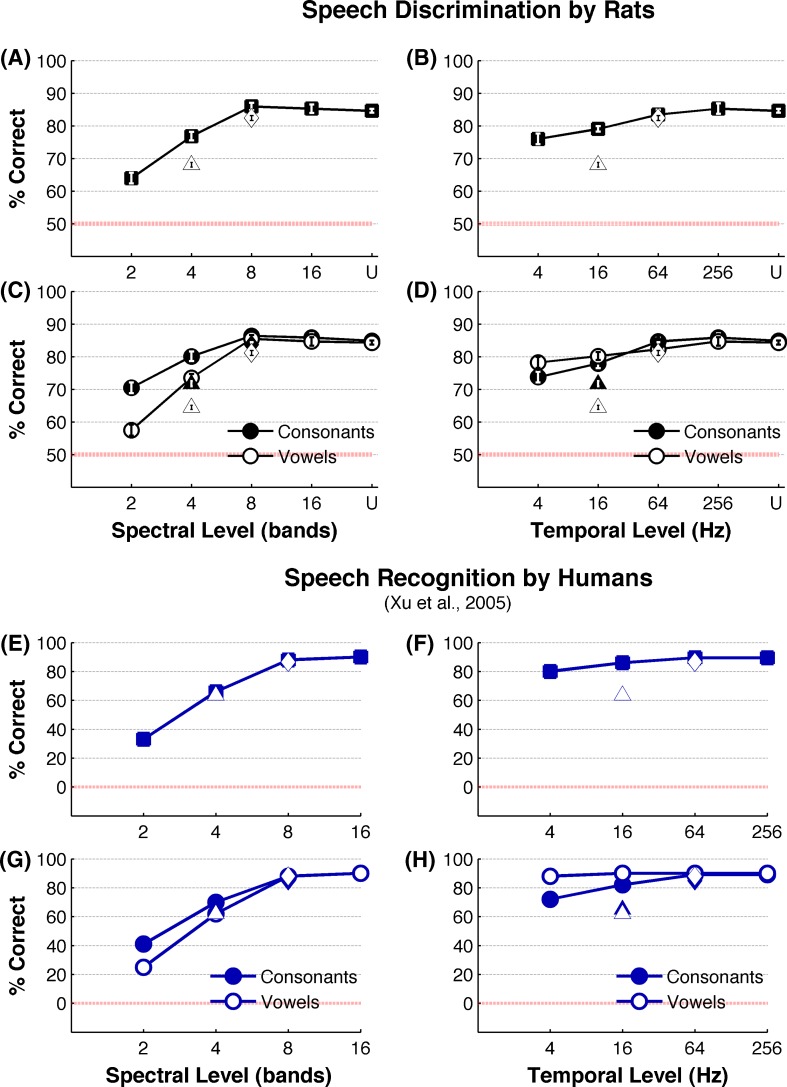FIG. 3.
Behavioral discrimination of degraded speech sounds. A Percent correct discrimination of speech (average across all six tasks which includes /d/ vs /b/, /d/ vs /s/, /d/ vs /t/, /dad/ vs /dud/, /dad/ vs /deed/, /dad/ vs dood/) by rats (n = 9) with spectral degradation. The squares indicate stimuli that are low-pass-filtered at 256 Hz, diamond at 64 Hz, and the triangle at 16 Hz. B Percent correct discrimination by rats (average across all six tasks which includes /d/ vs /b/, /d/ vs /s/, /d/ vs /t/, /dad/ vs /dud/, /dad/ vs /deed/, /dad/ vs /dood/) with temporal degradation. The squares indicate stimuli that are bandpass-filtered with 16 channels, diamond with eight channels, and the triangle with four channels. C Percent correct discrimination of consonant tasks (average of thee consonant tasks which includes /d/ vs /b/, /d/ vs /s/, /d/ vs /t/) and vowel tasks (average of three vowel tasks which includes /dad/ vs /dud/, /dad/ vs /deed/, /dad/ vs dood/) across levels of spectral degradation. The circles indicate stimuli that are low-pass-filtered at 256 Hz, diamonds at 64 Hz, and the triangles at 16 Hz. D Percent correct discrimination for consonants and vowels across levels of temporal degradation. The circles indicate stimuli that are bandpass-filtered with 16 channels, diamonds with eight channels, and the triangles with four channels. For A through D, error bars indicate SE. Note that most error bars of A through D appear smaller than the symbols. In all six tasks, ‘dad’ was the target stimulus. The rats correctly pressed the lever for a food reward for ‘dad’ and correctly rejected the lever for non-target stimuli. E Speech recognition performance by humans under spectral degradation. The squares indicate stimuli that are low-pass-filtered at 256 Hz, diamond at 64 Hz, and the triangle at 16 Hz. F Speech discrimination performance by humans under temporal degradation. The squares indicate stimuli that are bandpass-filtered with 16 channels, diamond with eight channels, and the triangle with four channels. G Recognition of vowels and consonants by humans under spectral degradation. The circles indicate stimuli that are low-pass-filtered at 256 Hz, diamonds at 64 Hz, and the triangles at 16 Hz. Recognition of vowels and consonants by humans under temporal degradation. The circles indicate stimuli that are bandpass-filtered with 16 channels, diamonds with eight channels, and the triangles with four channels. The red line marks the chance performance. Note that human study has the chance performance at 0 %, and the current study has the chance performance at 50 %. The data for E through H are from Xu et al. 2005. U = undegraded.

